Wild cats in the Americas are spread throughout the continent, from the Arctic circle in the north to Patagonia in the south.
These American wild cats (read: American as in American continent) are among the cutest, strongest, and most remarkable types of wild cats.
In today’s article, you will learn more about these incredible felines’ behavior, diet, and distribution. Let’s get to it!
13 Wild Cats in the Americas
For better organization, we divided this article into three categories: small wild cats, medium wild cats, and big wild cats in the Americas. We hope you enjoy learning about the cat family!
Small Wild Cats in the Americas
Andean Cat (Leopardus jacobita)

- Lifespan: up to 16 years
- Tail length: 16 to 19 inches
- Body length: 22 to 29 inches
- Height: about 14 inches
- Weight: 8.8 to 13 pounds
- Top speed: unknown
Among the South American wild cats, the Andean cats (Andean mountain cats) are perhaps the most stunning small felines.
The body’s sides are covered in brown-yellowish spots that are spread in vertical lines, giving the fur the illusion of continuous stripes. The fur is primarily ash gray.
Andean cats are mostly found at altitudes up to 16,400 feet in the Andean Mountains of Bolivia, Peru, Chile, and Northern Argentina. They were discovered recently outside of the Andes, though.
Considering they can only be found in the rocky, dry, and semi-arid regions, Andean cats have a very specific habitat.
Those American cats eat lizards, small birds, waterfowl, and small mammals, like the mountain viscacha, which is the main part of their diet.
In addition, Andean cats are mostly solitary animals, but during mating season and after births, they may be found in pairs or with cubs. According to IUCN, Andean cats are Endangered species.
Pampas Cat (Leopardus colocola)
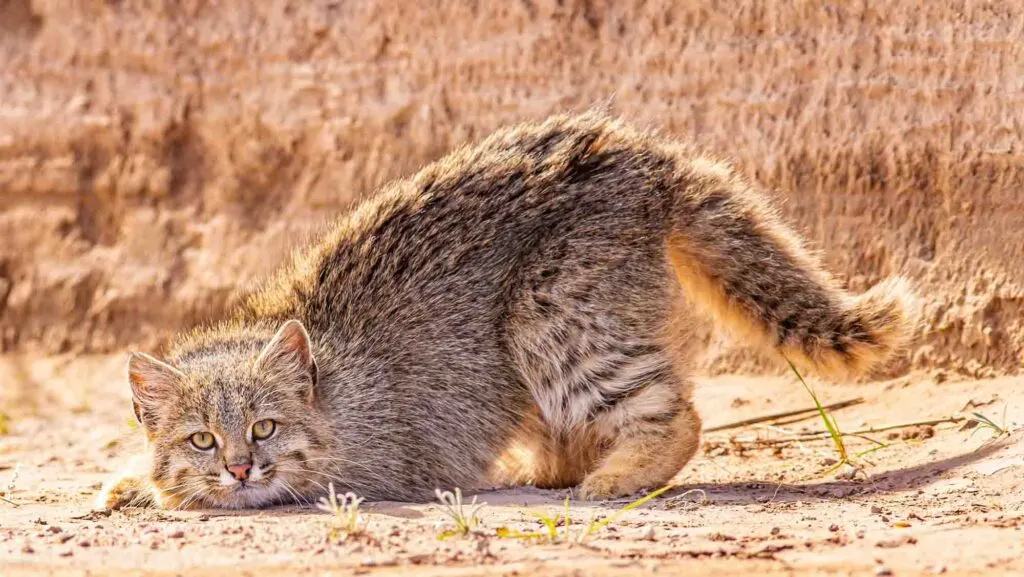
- Lifespan: between 9 to 18 years
- Tail length: 8.5 to 13 inches
- Body length: 16.5 to 31 inches
- Height: about 12 and 14 inches
- Weight: 5 to 11 pounds
- Top speed: unknown
Pampa cats resemble large domestic cats, and their color might range from grayish yellow, grayish white, silver gray, light gray, or grayish-brown.
They have rather large, amber eyes, a broad head, and a short nose. Their pointed ears are black on the back and have a silvery white patch in the middle.
Further out, Pampas cats are widely distributed throughout much of South America. Argentina, Bolivia, Brazil, Chile, and Peru are the countries where they can be found.
They inhabit more different types of environments than any other wild cats in America. They are found in grassland, forests, savanna, shrubland, and desert.
Various tiny mammals, including guinea pigs and, in particular, small rodents like leaf-eared mice and mountain viscacha, are part of Pampas cats’ diet.
According to IUCN, they are listed as Near Threatened due to loss of habitat and degradation due to oil extraction and agriculture.
Margay (Leopardus wiedii)
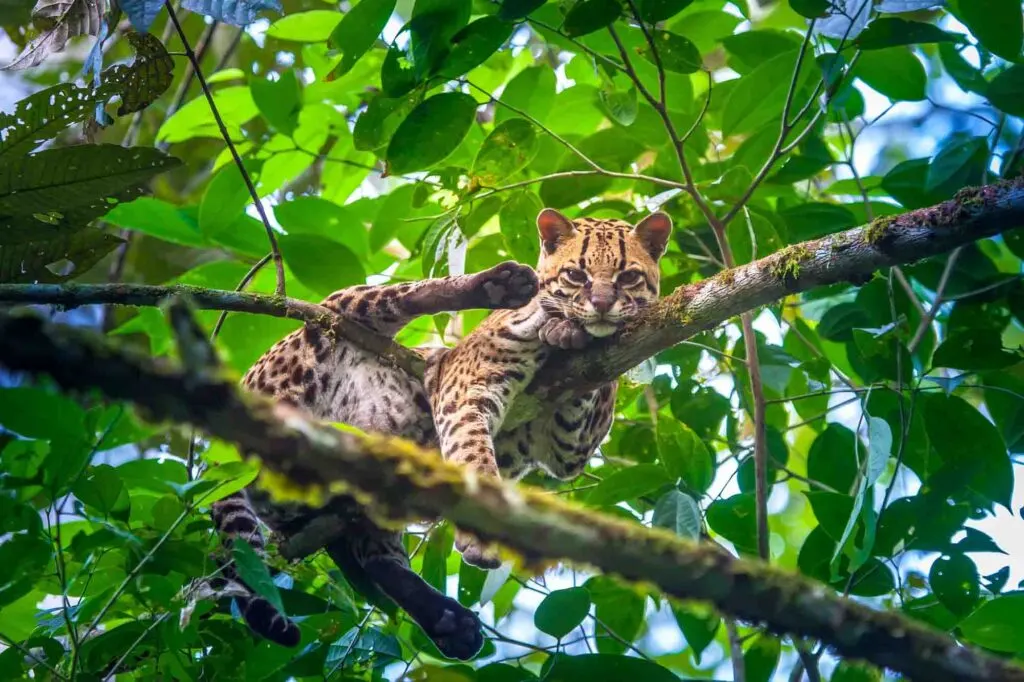
- Lifespan: up to 22 years
- Tail length: 9 to 20.5 inches
- Body length: 18 to 27 inches
- Height: about 24 inches
- Weight: 5 to 11 pounds
- Top speed: 80 mph
Margays are small wild cats, mainly found in Central and South America. Still, it is also present in North America.
Unlike some American cat species, margays prefer humid tropical and subtropical evergreen and montane cloud forests.
Margays primarily hunt on the ground but can also catch animals in trees.
Appearance-wise, their body is covered in black dots, stripes, and blotches that run lengthwise over their coat, which is brownish yellow to tan.
According to IUCN, margays are listed as Near Threatened because of illegal hunting and pet trade. In fact, margays were one of the most exploited wild cats of the Americas in the 1980s.
Geoffroy’s Cat (Leopardus geoffroyi)
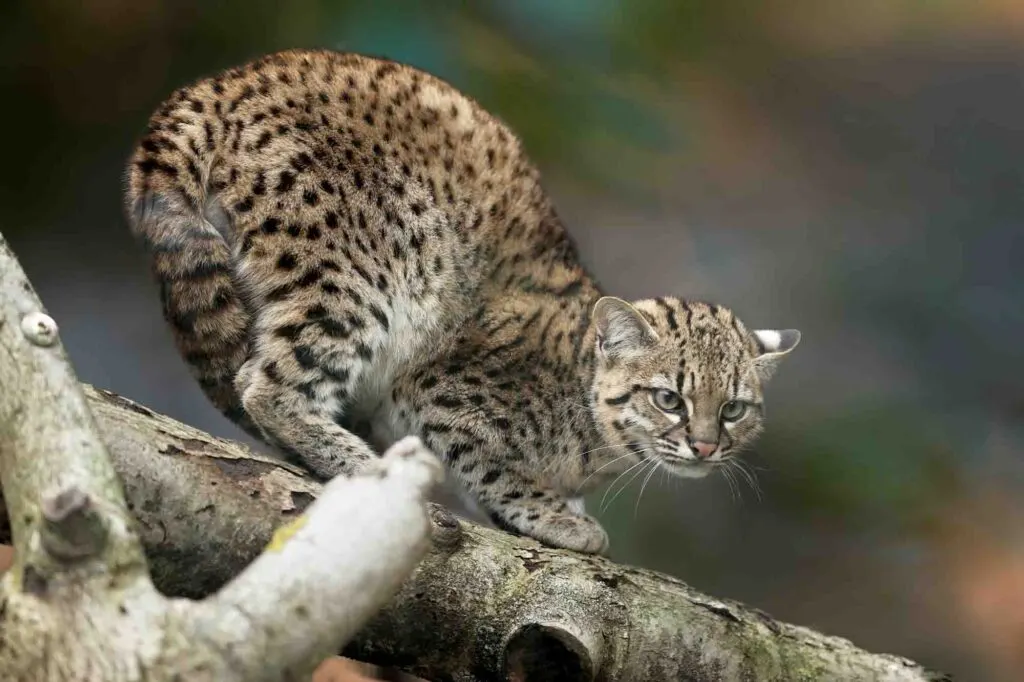
- Lifespan: up to 14 years
- Tail length: 9 to 16 inches
- Body length: 17 to 35 inches
- Height: 6 to 10 inches
- Weight: 6.5 to 13 pounds
- Top speed: unknown
Among the wild cats in America, Geoffroy’s cats are the most widespread and abundant in their range.
They inhabit savannas, pampas, open woodlands, shrubland with cover as well as grasslands and marshy areas of Argentina, Bolivia, Brazil, Paraguay, and Uruguay.
Although they can climb effectively and do spend some time in trees, Geoffroy’s cats spend most of their time on the ground.
Appearance-wise, they are approximately as large as housecats. The cats that live in the northern part of their range have brownish-yellow coat, while the ones that live in the southern parts can be grayish.
Geoffroy’s cats are opportunistic predators that eat whatever is most available. They primarily hunt on land, although they may also hunt frogs and fish in water. Locals refer to them as “fishing cats” and claim they are good swimmers.
They are listed as Least Concern on the IUCN Red List.
Northern Tiger Cat (Leopardus tigrinus)
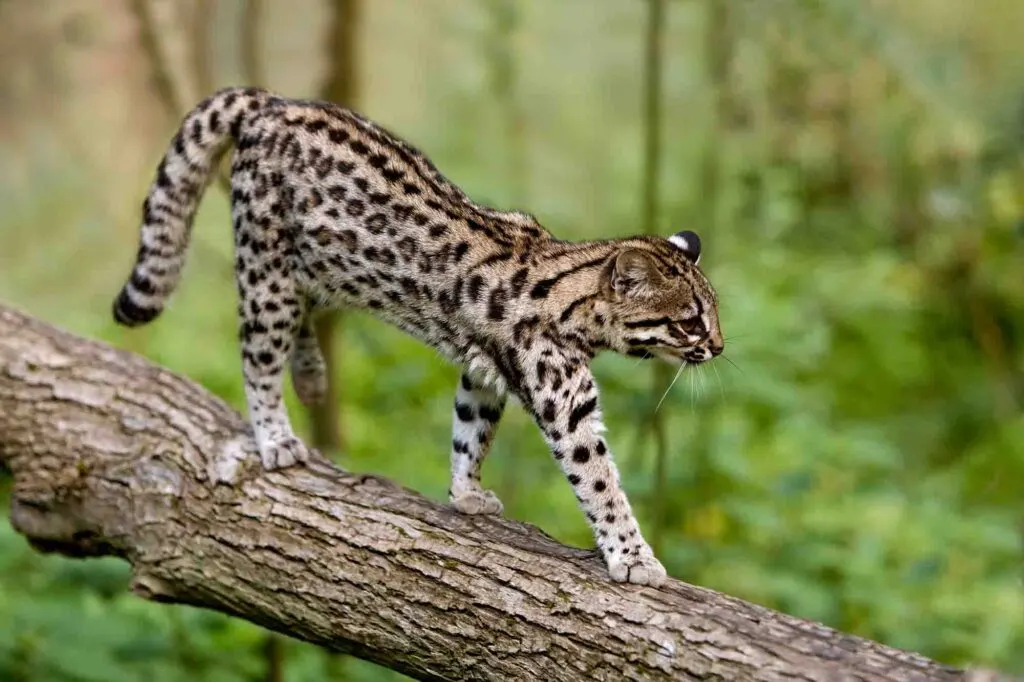
- Lifespan: between 15 to 21 years
- Tail length: 8 to 16.5 inches
- Body length: 15 to 23 inches
- Height: about 8 inches
- Weight: 4 to 7.7 pounds
- Top speed: unknown
The tiger cats are members of the Ocelot lineage, one of the most recent cat lineages.
They are very similar to margays and ocelots but are smaller and slender. Also known as oncillas, these wild cats have thick fur ranging from light brown to dark ochre with dark rosettes.
At night, these wild cats are active and have a solitary lifestyle. Although little information is comprehended about the northern tiger cat’s diet, it is known that it primarily consists of small mammals, birds, and reptiles.
The IUCN Red List ranks the northern tiger cat as Vulnerable.
In addition, these cats’ range extends from Central America across South America up to Central Brazil.
Southern Tiger Cat (Leopardus guttulus)
- Lifespan: between 15 to 21 years
- Tail length: 8 to 16 inches
- Body length: 15 to 23 inches
- Height: about 8 inches
- Weight: 4 to 7.7 pounds
- Top speed: unknown
The average weight of southern tiger cats is only 5 pounds, making them one of the smallest species among the wild cats on the continent.
These wild cats of America (continent) can be found in eastern Paraguay, central and southern Brazil, and northeastern Argentina.
They inhabit a wide range of environments, including open grasslands, seashore vegetation, and deep tropical and subtropical rainforests.
Although the southern tiger cats’ diet is still mostly unknown, it is believed to mainly consist of small mammals, birds, and reptiles.
According to the IUCN Red List, southern tiger cats are listed as Vulnerable.
Guiña (Leopardus guigna)
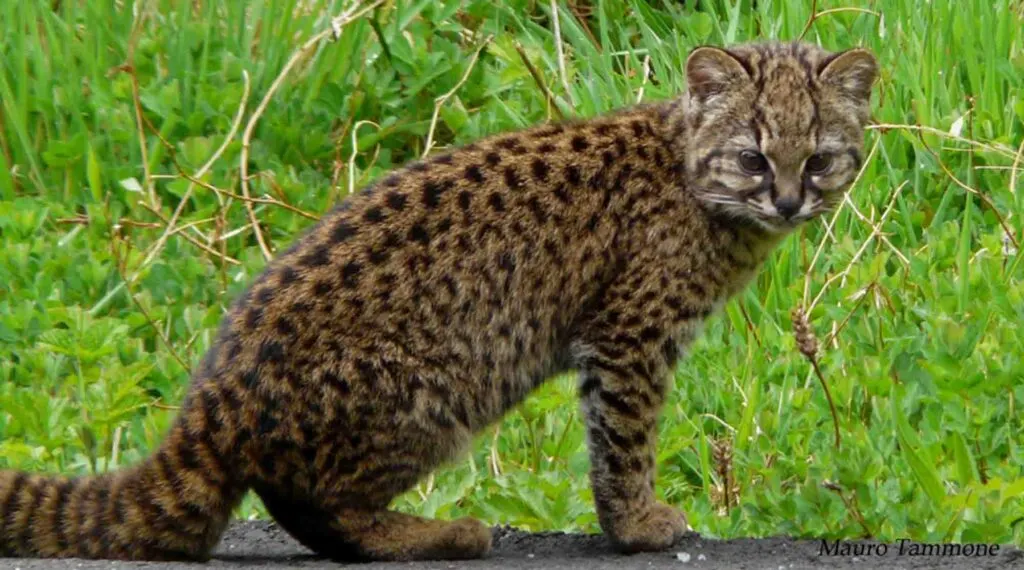
- Lifespan: up to 11 years
- Tail length: 8 to 10 inches
- Body length: 14.5 to 22 inches
- Height: about 10 inches
- Weight: 3 to 6.5 pounds
- Top speed: unknown
When it is about wild cats of the Americas, we have to mention guiña (also known as kodkod), which is the smallest wild cat in the Americas.
Native to central and southern Chile and southwestern Argentina, these American cats live in temperate rainforests and coastal ranges.
Appearance-wise, kodkods’ coat ranges from brownish-yellow to grayish-brown with dark spots, a pale underside, and a ringed tail.
The IUCN Red List has categorized guiña as Vulnerable, and their biggest threats include habitat loss.
Jaguarundi (Herpailurus yagouaroundi)
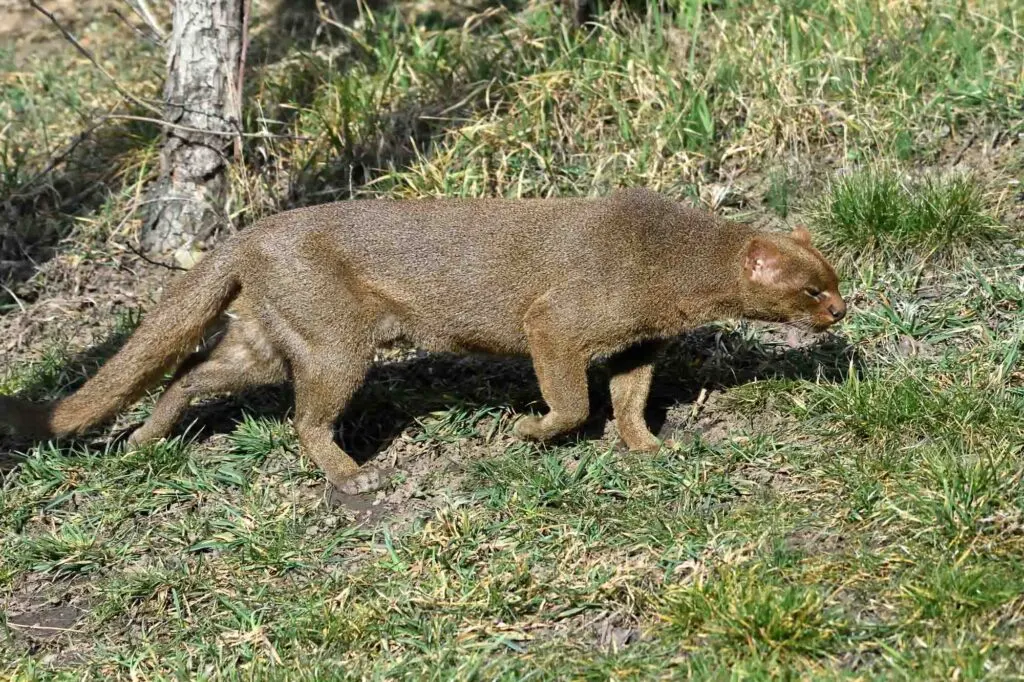
- Lifespan: between 10 to 20 years
- Tail length: 11 to 23 inches
- Body length: 19 to 30 inches
- Height: about 10 to 24 inches
- Weight: 5.5 to 17 pounds
- Top speed: 60 mph
The last of the small wild cats in America, Jaguarundi, has one of the oddest appearances.
They resemble otters more than other members of the feline family because of their long, thin tails, flattened heads, and lengthy bodies.
These American wild cats are the most widely distributed among the small cats in America and the second most widespread carnivore in the Americas after the puma.
Jaguarundis can be found in northern Mexico through Central America and Argentina’s central region.
These cats live in a variety of open and closed environments, including grasslands, dry scrub, savannah, and primary forests.
Jaguarundis are unique for having a trait that is quite uncommon in cats: they have at least three different sounds it uses to communicate.
According to the IUCN Red List, these small wild cats are classified as Least Concern.
Medium Wild Cats in the Americas
Ocelot (Leopardus pardalis)
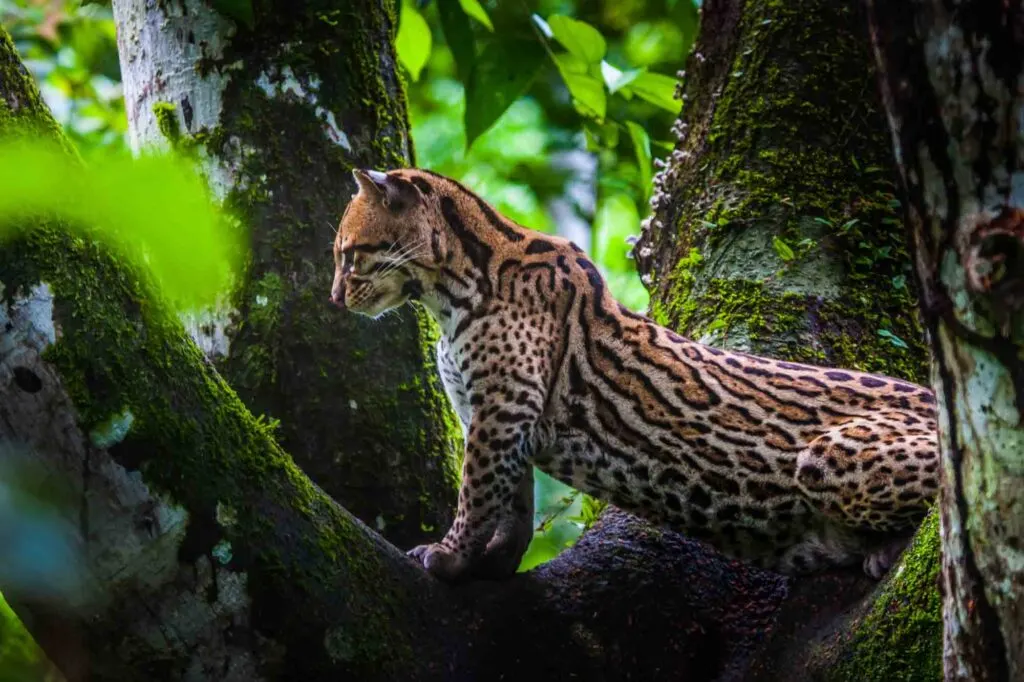
- Lifespan: up to 10 years in the wild; up to 20 years in captivity
- Tail length: 12 to 20 inches
- Body length: 20 to 40 inches
- Height: about 20 inches
- Weight: 17.5 to 33 pounds
- Top speed: 38 mph
Ocelots are sleek, medium-sized animals with lovely speckled coat that is twice the size of the typical house cat.
These nocturnal cats mainly hunt rabbits, rats, iguanas, fish, and frogs with the help of their excellent vision and hearing.
They also climb trees and pursue monkeys or birds. Ocelots can swim very well and, unlike many other American cats, don’t avoid the water.
Ocelots can be found from south Brazil to far north in Texas, where they can be found in brushlands.
These cats can be adapted to human environments and are occasionally seen close to villages or other populated areas.
Most nations where ocelots live, including the United States, have laws protecting them.
Bobcat (Lynx rufus)
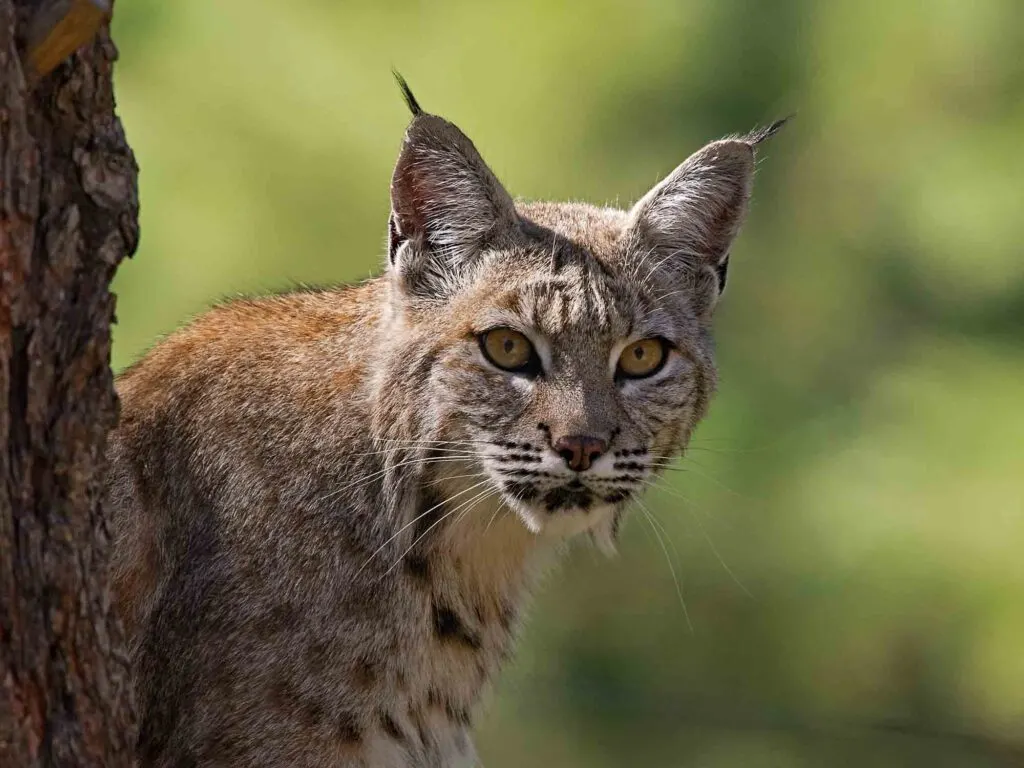
- Lifespan: 10 to 17 years
- Tail length: 3.5 to 10 inches
- Body length: 1.6 to 4 feet
- Height: about 21 inches
- Weight: 13 to 44 pounds
- Top speed: 30 mph
Bobcats are one of the most beautiful wild cats in America. They were given this name because of their small, bobbed tail, which has a black tip and is around 6 inches long.
These cats can be found in North America, from Mexico to Canada.
Bobcats typically consume mice, birds, fish, insects, lizards, rabbits, and other small wild animals.
Although it is a rare thing, bobcats are capable of swimming.
They are classified as Least Concern according to the IUCN.
Canada Lynx (Lynx canadensis)
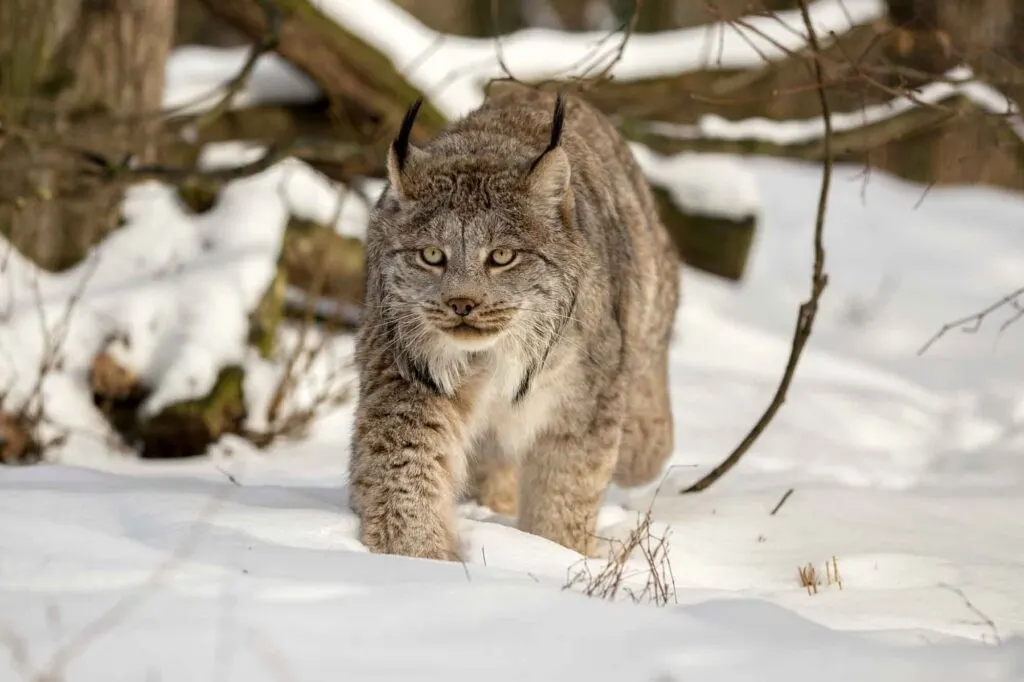
- Lifespan: up to 16 years
- Tail length: 4 to 6 inches
- Body length: 2.4 to 3.5 feet
- Height: 19 to 22 inches
- Weight: 17 to 26 pounds
- Top speed: 50 mph
The last of the medium-sized wild cats of North America is known as the Canada lynx, the only lynx in the Americas. The other two lynx species–the Eurasian lynx and the Iberian lynx–are both wild cats of Europe.
These North American wild cats have distinguished long ear tufts, flaring facial ruff, and short bobbed tails with a wholly black tip. Their paws are very big and function as snowshoes in extremely deep snow.
Native to North America, Canada lynxes live in a region that extends from the tree line in the Arctic through coniferous forests in Alaska and the dense boreal forest of Canada to the Blue Mountains and the Rocky Mountains in the United States.
Adults normally avoid each other, with the exception of the winter breeding season.
These beautiful animals hunt largely at night and are visual predators, but they also have good hearing.
Snowshoe hares are the main prey for the Canadian lynx, but they also eat rodents, birds, fish, and deer. On the IUCN Red List, they are ranked as Least Concern.
Big Wild Cats in the Americas
Puma (Puma concolor)
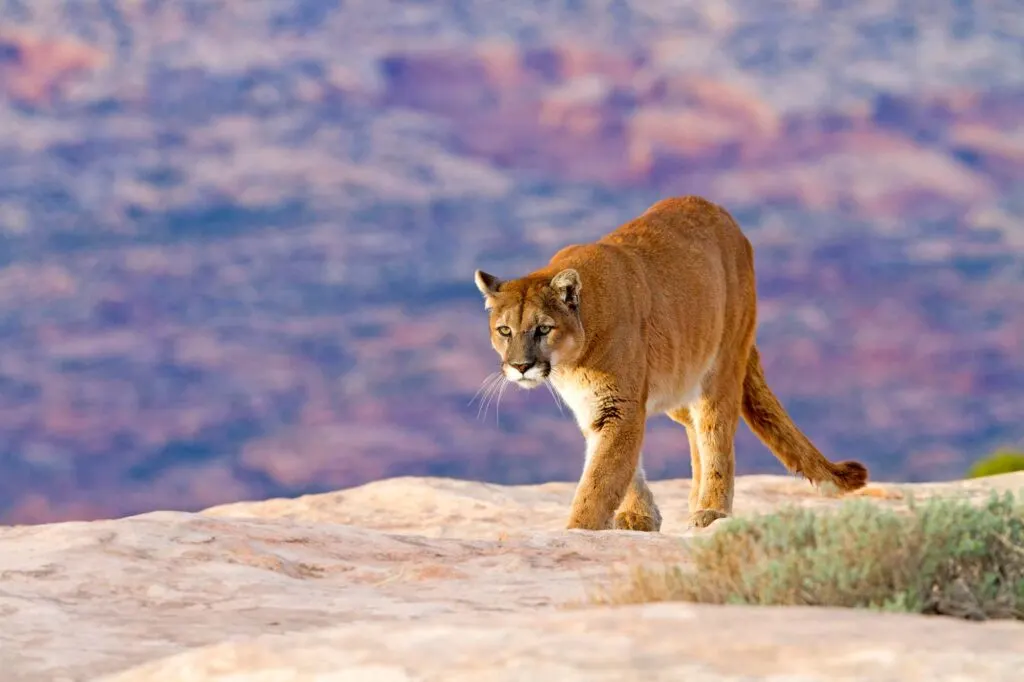
- Lifespan: 8 to 13 years
- Tail length: 2 to 3 feet
- Body length: 3.3 to 5 feet
- Height: 24 to 35 inches
- Weight: 65 to 220 pounds
- Top speed: 50 mph
Known by many names, puma is also called cougar, mountain lion, panther, and catamount.
They are usually reddish in tropical regions and grayish tawny in colder regions.
These American cats are the second-largest in the continent, and their range extends from the Yukon Territory in North America down to the Andes in South America. Out of all the wild cats in America, the puma has the broadest range.
Due to the Pumas’ nocturnal behavior, it is possible that they will be active at dawn and dusk.
Pumas can survive in a variety of natural habitats, from forests to deserts, and are incredibly adaptable species. Also, they are outstanding ambush predators and incredible jumpers.
Pumas can be recognized during the day, despite the fact that they prefer to move in the shadows. They eat mostly large mammals, such as mule deer, elk, moose, mountain goats, and white-tailed deer.
Although pumas are big cats, they are not always the apex predator in their range. Often, other larger predators like the jaguar, gray wolf, and grizzly bear take this position.
Did you know? Pumas are the only big cats in North America!
Jaguar (Panthera onca)
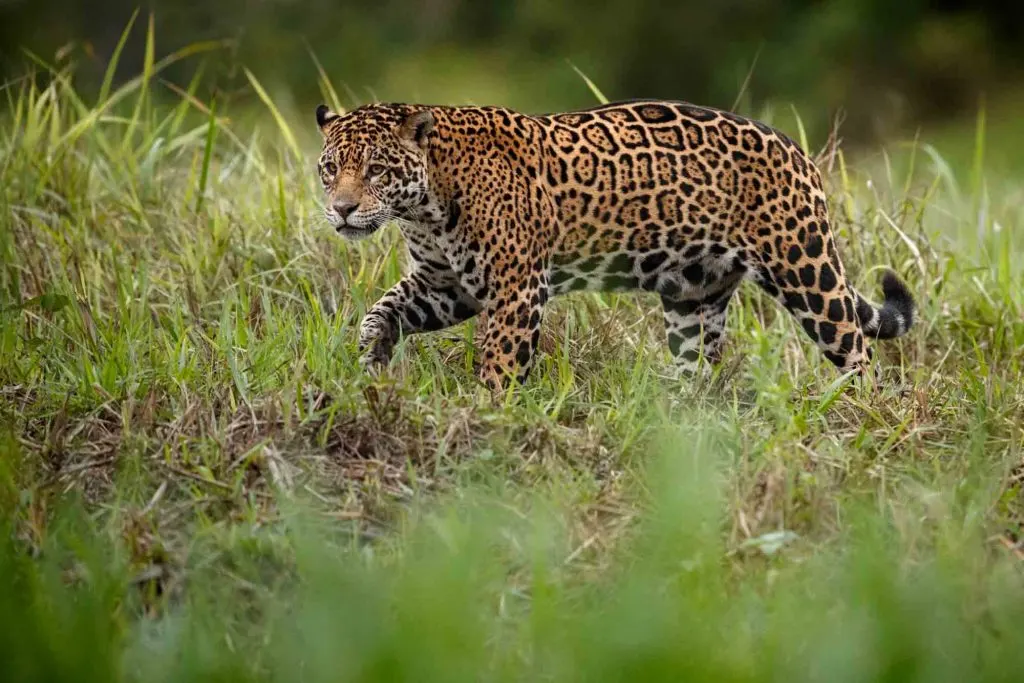
- Lifespan: 12 to 16 years
- Tail length: 18 to 30 inches
- Body length: 3.8 to 6.1 feet
- Height: 2 to 2.5 feet
- Weight: 100 to 250 pounds
- Top speed: 50 mph
Worshipped as gods in many ancient cultures, jaguars are powerful big cats in South America that are considered the kings of the Amazon Rainforest.
Full of superlatives, jaguars are the third-largest cat in the world, behind tigers and lions, and the largest big cat native to the Americas.
Slender and muscular, jaguars have pale yellow to tan-colored coat, which is uniquely marked with dark rosette spots. Each spot is different, and they vary in shape. Rosettes may even include several dots instead of one.
Unlike other wild cats, jaguars do not avoid water, in fact, they have decent swimming abilities, and they hunt fish, turtles, and even caimans. Needless to say, they are the apex predators in the Amazon.
They live in savannas and grasslands in addition to the tropical rainforests where they are frequently found.
Jaguars’ conservation status on the IUCN Red List is Near Threatened.
Did you know? Jaguars have the most powerful bite of all big cats, making them one of the strongest animals in the world.
Did you enjoy learning about the wild cat species of the Americas? Then share this article with your friends!

Sharon Porter
Monday 12th of September 2022
Wonderful article.
Thank you
Delia Bristow
Saturday 3rd of September 2022
Enjoyed this article. Very informative.
RICKY L JOHNSON
Friday 2nd of September 2022
You forgot the panther
Wildlife Explained
Tuesday 13th of September 2022
Hey Ricky, the panther is just another name for the cougar, or puma, if you will.